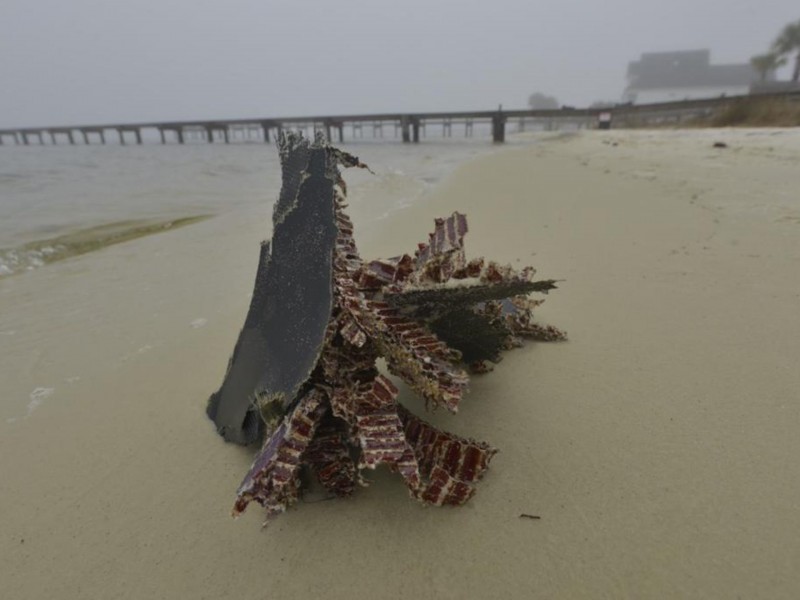Seven Marines and four Army aircrew were presumed dead Wednesday after their Black Hawk helicopter crashed into waters off the Florida Panhandle during a nighttime training mission.
By late Wednesday morning, human remains had washed ashore in the area near Eglin Air Force Base, base spokeswoman Jasmine Porterfield said.
She didn’t specify what was found, noting a search-and-rescue mission remained underway. Still, there was little hope for a miracle, with Gen. Martin Dempsey — chairman of the Joint Chiefs of Staff — expressing his condolences.
He said the crash was “a reminder to us that those who serve put themselves at risk, both in training and in combat.”
“We will work with the services to ensure that … their family members will be well cared for.”
The Black Hawk was first reported missing during foggy conditions at about 8:30 p.m. (9:30 p.m. ET) Tuesday. Hours later, searchers found debris around Okaloosa Island near Eglin, base spokesman Andy Bourland said. This debris washed up on both the north and south sides of Santa Rosa Sound, which connects mainland northern Florida and a barrier island.
The Air Force, Coast Guard and civilian agencies participated in the intensive search focused on where they believe the aircraft went down, in waters east of the town of Navarre and the Navarre Bridge and near Eglin testing range site A-17.
Porterfield said approximately 100 people were involved in canvassing the ground and the waters, looking for debris: “It’s a huge effort underway.”
That effort was helped by the rising sun, but not the shrouding fog, according to Eglin spokeswoman Sara Vidoni.
“We’re working closely with all the parties involved to locate our Marines and the Army crew that were onboard,” added Capt. Barry Morris, a spokesman for the U.S. Marines Corps Special Operations Command. “And, really, just our thoughts (and) prayers are with the Marines, the soldiers and the families of those involved in the mishap.”
Second Black Hawk got back safely
No one is saying what caused the accident, witlh Vidoni indicating only that there’s no indication of anything suspicious.
There was heavy fog in the area when the aircraft went missing, though the Eglin spokeswoman said it’s too early to tell whether that had anything to do with the crash.
“There is training in all conditions — that’s part of the military mission,” Vidoni said. “They were out there doing what the military does.”
According to Morris, the service members — all men — were involved in a seven-day training exercise of amphibious operations. It involved small boats and inserting and extracting Marines from the water via helicopter. Morris would not say in which phase of the training the Marines were on Tuesday night.
The UH-60 helicopter wasn’t alone when it went down. A second Black Hawk — assigned to 1-244th Assault Helicopter Battalion based in Hammond, Louisiana — safely returned to the base, some 40 miles east of Pensacola.
The aircraft were both assigned to the Louisiana Army National Guard out of Hammond and taking part in what the U.S. military called a “routine training mission involving the Marine Special Operations Regiment” out of Camp Lejeune.
“Whatever the trouble was with the one aircraft, it did not involve the second helicopter that was participating in the exercise,” Bourland said.
Seven Marines based out of Camp Lejeune
The Army aircrew members belonged to the Army National Guard unit out of Louisiana, part of a unit that Gov. Bobby Jindal said “have fought courageously overseas in defense of our nation and here at home.”
By 11:15 a.m., relatives of all four of those guardsmen had been notified, though their names won’t be released publicly until the Coast Guard recovers their bodies or calls off the search, said Col. Pete Schneider, a Louisiana National Guard spokesman.
“They have protected what matters most during times of crisis,” Jindal said. “These soldiers represent the best of Louisiana, and we are praying for them and their families.”
Morris said the Marines involved in the crash were all “highly-trained” members of that service’s special operations command. They were based out of Camp Lejeune, an expansive North Carolina base that is home to about 170,000 active deputy, dependent, retired and civilian personnel.
The pilots were instructor pilots, Maj. Gen. Glenn Curtis told reporters. He said the whole crew had several thousand combined hours of operation flying the Black Hawk.
In January, two Marines died when their helicopter went down at the Marine Corps Air Ground Combat Center in Twentynine Palms, California.
And last March, an F/A-18C Hornet’s pilot died after a crash about 70 miles east of Naval Air Station Fallon in western Nevada.
This week’s crash involved a UH-60 Black Hawk, a twin-engine helicopter introduced into Army service in 1979 in place of the iconic UH-1 Huey. Other branches have modified the Black Hawk for their own uses, including the Navy’s SH-60 (the Sea Hawk), the Air Force’s MH-60 (the Pave Hawk) and the Coast Guard’s HH-60 (the Jayhawk).
The Army’s UH-60 helicopter, which has a maximum speed of 173 mph, has an airframe “designed to progressively crush on impact to protect the crew and passengers,” according to the service.
As Morris, the Marine spokesman, pointed out, those who get on such aircraft or take part in other military exercises aren’t always out of danger just because they’re off the battlefield.
“We have a requirement to conduct realistic military training,” he said. “And unfortunately this mishap happened.”
